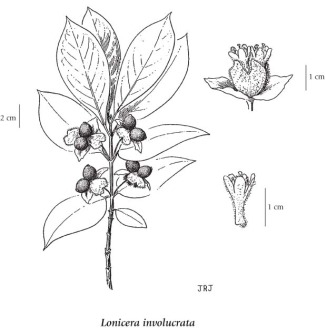Lonicera involucrata (Richardson) Banks ex Spreng.
black twinberry (bearberry honeysuckle; twinberry honeysuckle)
Caprifoliaceae (Valerian family)
Introduction to Vascular Plants
black twinberry (bearberry honeysuckle; twinberry honeysuckle)
Caprifoliaceae (Valerian family)
Introduction to Vascular Plants
SUBTAXA PRESENT IN BC
Lonicera involucrata var. involucrata
Introduction
Black twinberry is a deciduous species of shrub that is found across North America. In British Columbia, it is commonly found in the lower two thirds of the province. Habitat includes moist forests and thickets with moist nitrogen-rich soils (Douglas et al. 1998, Klinka et al. 1989). It is tolerant of fluctuating groundwater levels (Klinka et al. `989). It is readily identified by the yellow tubular flowers that occur in pairs, and the black shiny berries.
|
Species Information
General:
Deciduous, erect to straggly shrub, 0.5-5 m tall; young twigs 4-angled, greenish, glabrous; older stems with yellowish-grey, shredding bark.
Leaves:
Opposite, short-stalked, elliptic to oblanceolate or broadly lanceolate, 3-16 cm long, 2-8 cm wide, entire, rounded or tapered at base, abruptly sharp-pointed at tip, pale and glabrous or somewhat hairy beneath.
Flowers:
Inflorescence of short-stalked pairs of flowers cupped by large (2 - 4 cm across) involucres of 2 pairs of fused bracts, on 1-4 cm long stalks in leaf axils; corollas tubular bell-shaped, yellow, 1-2 cm long, glandular hairy on outside, scarcely 2-lipped with 5 roughly equal lobes above; corolla tubes with short thick spurs at bases.
Fruits:
Berries, shiny black, 0.8-1.2 cm across, paired, loosely surrounded while young by paired bracts, which darken and redden (to purplish-maroon) as they recurve from the maturing fruits.
Illustration

If more than one illustration is available for a species (e.g., separate illustrations were provided for two subspecies) then links to the separate images will be provided below. Note that individual subspecies or varietal illustrations are not always available.
Illustration Source: The Illustrated Flora of British Columbia
USDA Species Characteristics
Flower Colour:
Yellow
Blooming Period:
Summer
Fruit/Seed characteristics:
Colour: Black
Present over the Summer
Source: The USDA
Ecology
Ecological Framework for Lonicera involucrata
The table below shows the species-specific information calculated from
original data (BEC database) provided by the BC Ministry of Forests and Range.
(Updated August, 2013)
The table below shows the species-specific information calculated from
original data (BEC database) provided by the BC Ministry of Forests and Range.
(Updated August, 2013)
| Site Information |
Value / Class |
||
|
Avg |
Min |
Max |
|
| Elevation
(metres) |
1065 | 0 | 2460 |
| Slope
Gradient (%) |
12 | 0 | 235 |
|
Aspect (degrees) |
3 | 0 | 360 |
| Soil
Moisture Regime (SMR) [0 - very xeric; 4 - mesic; 8 - hydric] |
4 | 0 | 8 |
| Modal
Nutrient Regime
Class |
C | ||
| #
of field plots species was recorded in: |
8661 | ||
| Modal
BEC Zone Class |
SBS | ||
|
All BEC Zones (# of stations/zone) species was recorded in |
AT(6), BG(9), BWBS(388), CDF(32), CWH(256), ESSF(1667), ICH(1260), IDF(405), IMA(1), MH(1), MS(951), PP(9), SBPS(252), SBS(2975), SWB(1) | ||
|
Source:
Klinkenberg 2013
|
|||